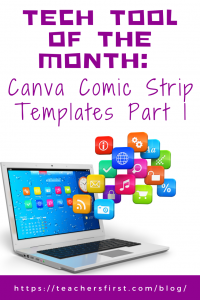Canva’s Comic Strip Templates provide an opportunity to design, share, and download high-quality comic strips. Choose from the various colorful design options and formats (such as single strips or multiple frames). After you select your template, choose the link to Customize This Template. Each template includes several pages, and additional pages can easily be added by clicking the + sign for a blank page or right-clicking to duplicate the page. When you finish your comic strip, you can download your finished cartoon to your device as a PDF, JPG, or GIF. You can also share the cartoon strip on social media or click to share the URL. Canva offers an Educator Account that includes the Pro features and allows students younger than 13 access to the tool using the classroom section, with no student email necessary.
Applying the Triple E Framework
The Triple E Framework, created by Dr. Liz Kolb, believes that “effective technology integration begins with good instructional strategies and not fancy tools” (tripleeframework.com). Dr. Kolb wrote a book on the topic, Learning First, Technology Second (ISTE, 2017), that lays out the three main uses for technology in education: to Engage, Enhance, or Extend learning goals. We can use this framework to decipher why we use specific classroom tools. Here is a rubric based on the Triple E Framework you can use to evaluate whether Canva Comic Strip Templates (or any other technology) is a good fit with your learning goals and whether you should use it in your lesson.
- Engage in learning goals: The students are more focused on the task because they are creating their own comics at this site. The students are active social learners as they create comic strips. The students are motivated to begin learning as the numerous templates and images make the tool more engaging.
- Enhance learning goals: Canva Comic Strip Templates allow students to demonstrate a more sophisticated understanding of content by creating their own comic strips. Students also can use this tool to create a path to demonstrate their knowledge in a way that they cannot do without technology, as they can virtually share their finished comics.
- Extend learning goals: Dr. Kolb describes extended learning as an opportunity for students to learn, connect, and collaborate outside the regular school day and bridge the school day and real-life experiences. Canva Comic Strip Templates could be completed as a remote, flipped, or blended learning activity. The site would also make an ideal asynchronous learning experience.
SAMR Connection
The SAMR Model, by Dr. Ruben Puentedura, suggests that technology implementation has four levels. Therefore, we can use this model as a guideline to analyze how we use technology tools in the classroom. For example, creating a comic using the Canva Comic Strip Templates can be at the Substitution, Augmentation, and Modification levels, depending on what the student is doing.
- Substitution: The substitution level is the most basic level of SAMR and refers to when technology acts as a direct substitute without any functional improvements. An easy example could be students using Canva Comic Strip Templates to create comics rather than writing them on paper and stapling pages together.
- Augmentation: At the level of augmentation, the technology acts as a direct substitute and includes some functional improvements. We could take our comic activity to the level of augmentation by having students add images and text, change the layout of their comic, and share the comic privately with their teacher.
- Modification: The level of modification allows us to make (or modify) the activity into something more integrated with technology, meaning there is significant task redesign. Using the same comic activity, we could use Canva Comic Strip Templates and move to the level of modification by having students collaborate on their comics and share their projects with classmates using the provided URL.
Don’t miss Part 2 of the Tech Tool of the Month: Canva Comic Strip Templates, where we’ll discuss using the tool and classroom ideas. In the meantime, let us know how you have used Canva Comic Strip Templates in your education setting in the comment section below.


